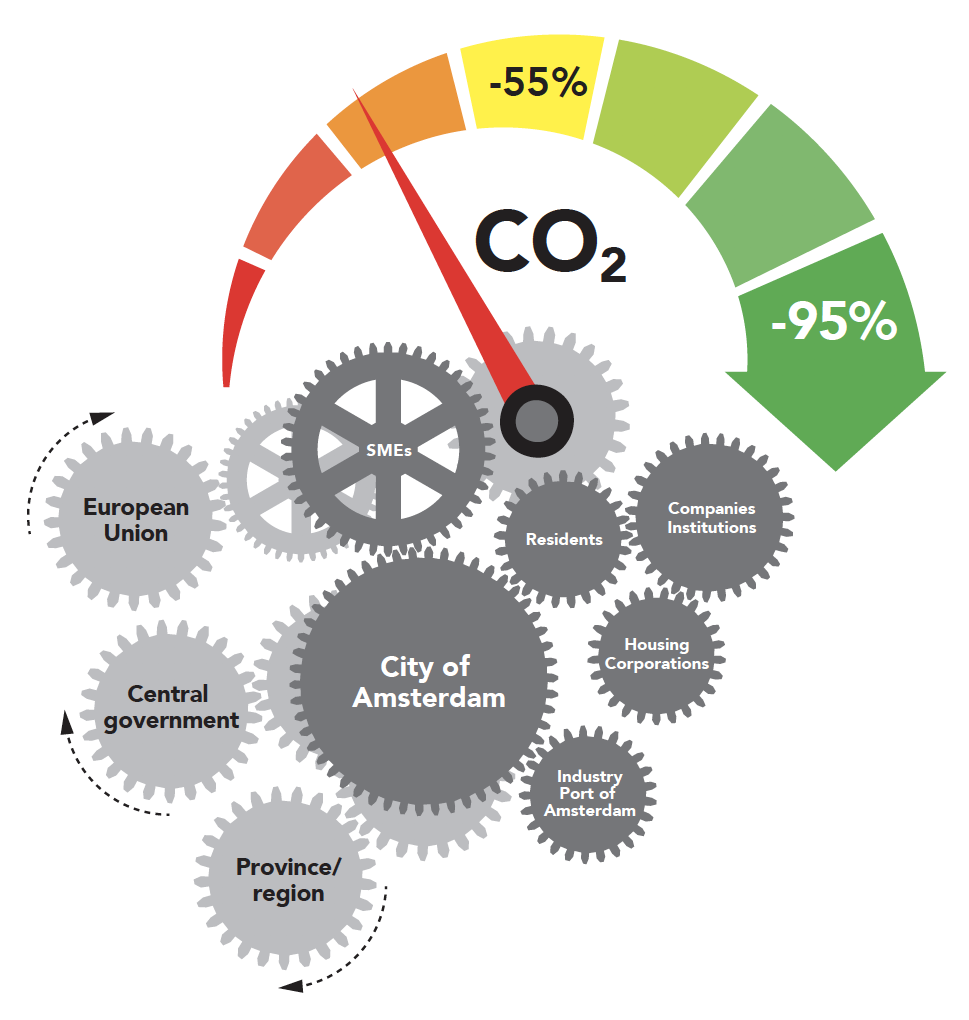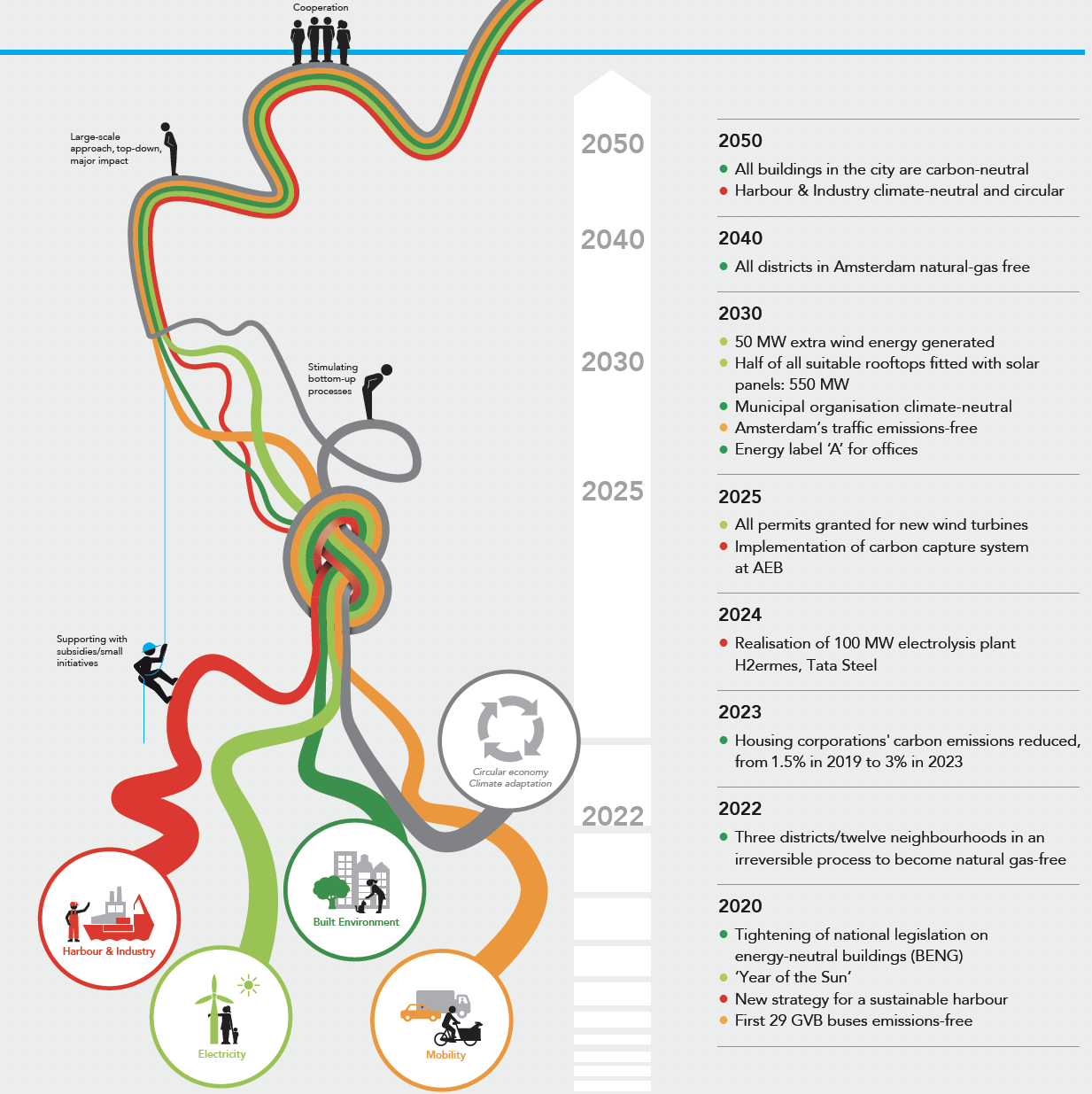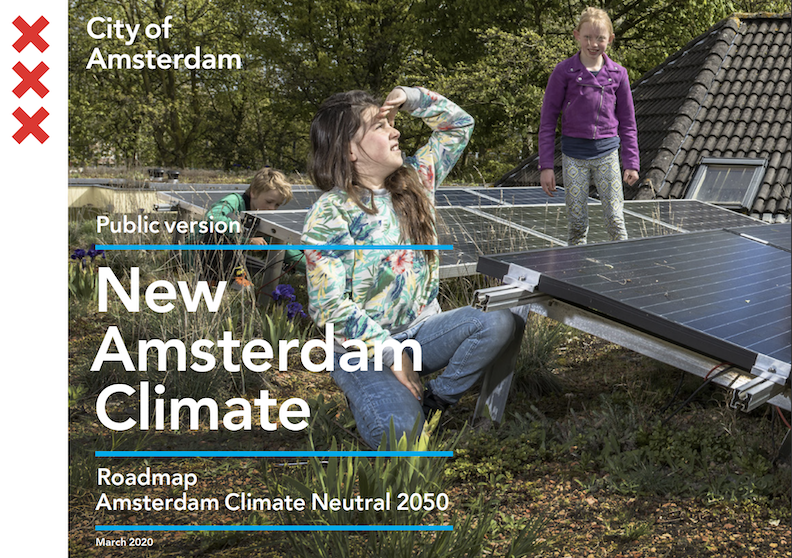Launch Of Amsterdam’s Climate Neutral Roadmap: An Interview With Deputy Mayor Marieke Van Doorninck
Q: Many cities aim for climate neutrality in 2050 – what makes Amsterdam’s roadmap special?
A: Cities are making a major contribution to climate change. Aside from the great responsibility, we also have more opportunities to take action to fight it, as there are lots of people living in close proximity. And we get a nicer city in return – not only for the current generation, but also for the generations to come. Cities are particularly unpleasant places to be in the heat and in the massive rain showers caused by climate change.
In 2050, Amsterdam will still be a great city in which to live and work. A healthy, prosperous and green city for everyone. And it will also be a city without coal, gas or oil, and it will have been free of polluting cars for twenty years. A city where energy is used economically, energy is generated sustainably, and raw and other materials are reused in a never-ending cycle.
The Amsterdam Climate Neutral Roadmap 2050 shows that this energy transition is possible, that it will bring opportunities, and that work in the city is already well underway. But the Roadmap also shows that the transition will be complex and risky.
The Roadmap marks the start of an irreversible, flexible process. The city is engaged in intensive cooperation, experimentation, data-gathering and learning. We’ll update the Roadmap every year in the future, including the climate budget.
Amsterdam is an ambitious and green frontrunner. We want to cut carbon emissions by 95% in 2050, compared to 1990, and to phase out natural gas completely in the city before 2040. As a step on the way, we’ll cut carbon emissions by 55% in 2030. Meanwhile, the Dutch government is aiming for a 49% reduction. We are ahead, and we hope that the government and the EU will follow us.
The Roadmap identifies four transition paths with accompanying measures: the built environment, electricity, mobility, and harbour and industry. We have made detailed calculations for all of the measures in Amsterdam, in order to lay a solid foundation for the coming years. In principle, these measures will lead to the intended 55% cut in carbon emissions in 2030, in ten years’ time.
The climate budget is our monitor and our steering instrument. Annual monitoring allows us to keep a finger on the pulse, so we can make adjustments and come up with new measures if necessary. We reflect on the past and look to the future.
For a compact, historical European city such as Amsterdam, the energy transition is a major challenge. Lots of space is needed to generate, save, store and transport energy – and such space is scarce in a growing and increasingly densely-built city.
With the Roadmap, Amsterdam is showing that the energy transition is possible in a compact city.
The energy transition is not only a technical transition; above all, it is a social transition. In our vision, it will only succeed if we view the energy transition as a social transformation, we adopt climate justice as a guiding principle, and we work together.
In order to kickstart the movement in the city and maintain it, the municipality is playing different roles. We are working from the top down and the bottom up, and focusing our efforts and resources on the four transition paths.
Q: How does this fit in with the Amsterdam Climate Agreement?
A: The Amsterdam Climate Agreement marked the start of the New Amsterdam Climate platform. Almost 200 initiatives in the city are taking joint responsibility for building a climate-neutral city, and the movement is growing. The platform provides an overview, inspires people, and helps them to join in.
The Amsterdam Climate Agreement was established in 2019. We organised approximately 700 discussions, meetings and events across the city. We’re making inventories of what’s already happening and what has been planned. This bottom-up movement forms the basis of the Roadmap. Without initiative-takers in the city, without frontrunners, there would be no movement. The municipality is directing the process and has translated the overarching strategy into a roadmap.
Q: This year has been christened the year of the sun — how can the municipality be so confident that it will happen, and what project-related success have you had so far?
A: Amsterdam has a lot of roof surface, and we want to use this space optimally to generate sustainable energy. In the longer term, electricity can be generated on roofs for 400,000-500,000 households.
The advantage of solar panels is that installation is technically straightforward, and this also tends to be a profitable investment. Between 2012 and mid-2019, the number of solar panels in Amsterdam grew by 54% each year. If we maintain this growth of 54% in the coming years, we will meet the target of 250 MW in 2022. Growth will not be automatic, by any means; it will require a programmatic approach. Our aim is that no roof should remain unused.
We have opted for an approach whereby we inspire citizens and remove obstacles, so the opportunities created by solar energy generation can be used more effectively. The key parties for the generation of solar energy are the owners and users of buildings in the city.
If we don’t succeed in persuading the large roof-owners, in the longer term we’ll want to make the use of commercial roofs mandatory – but we’ll need the Dutch government and the EU for this.
We also need more support from central government for large solar projects. The autumn 2019 round of the sustainable energy subsidy (Stimuleringsregeling Duurzame Energie, SDE+) was heavily oversubscribed last year. As a result, 6,000 solar projects across the country were turned down. This could jeopardise our ability to meet this year’s climate targets. For Amsterdam, it could mean a potential decline of 62 MW in 2020. We are encouraging SDE+ subsidy-holders (whose applications have been approved) to redeem them and not allow them to expire.
Lots of great projects are underway in the city. There is considerable support among Amsterdam’s citizens. Solar panels have been installed on eighteen schools in Amsterdam Nieuw-west, in partnership with the municipality. These schools have jointly installed 6,000 panels, and fifty other schools are in the pipeline.
Three hundred and sixteen solar panels have been installed on the roof of the Hermitage Amsterdam. This is generating a considerable amount of electricity, comparable to the energy consumption of around thirty households. The Hermitage is the first monumental museum building in the Netherlands to install solar panels. Its monumental status made the process somewhat longer, but not impossible. Much more is possible than you’d think.
In addition to the solar energy programme, Amsterdam also has ambitious targets for generating wind energy. In the summer of 2019, we had 38 wind turbines with an installed capacity of 66 MW. After the summer, sixteen small wind turbines were removed. Ten large wind turbines will be installed in their place by 2022, bringing the total to 77 MW.

Q: How are you keeping Amsterdammers on board with your far-reaching plans?
A: If we do nothing, the citizens of Amsterdam will be hit hard by the consequences of climate change. Around the world, floods, changing temperatures and drought are having a big impact on societies, public health and the economy. When areas become uninhabitable due to a lack of drinking water or the inability to cultivate food, the prospect of war and refugee flows increases.
There is great support among Amsterdam’s citizens. Around 70%of citizens support the transition to sustainable, clean energy, and feel responsible for playing their part in the transition. This is shown by research by the municipality’s research department. Almost 60% of Amsterdam’s citizens think that climate change will have a major impact on Amsterdam. Only 5% of citizens think that climate change is exaggerated. Just over half of Amsterdam’s citizens have already taken sustainability measures. We are responding to this with the Climate Agreement and the New Amsterdam Climate platform.
We will also work to raise awareness among citizens, in order to highlight the urgency of the task. When it comes to saving the climate, there’s no time to lose. The steps towards the future need to be taken today.
Q: How does the notion of climate justice impact your ambitions? What is Amsterdam doing to ensure that the benefits and opportunities presented by the energy transition are the same for everyone
A: Greenhouse gas emissions are causing a fall in the quality of life around the world. Despite having the smallest share in global warming, poorest countries are being hit the hardest. The same is true of our children and the generations to come. In our city, the consequences of the energy transition are not equal for everyone, either. Some residents or neighbourhoods are more vulnerable or will benefit less from the opportunities offered by the energy transition. The Municipality of Amsterdam wants the energy transition to be a fair transition.
We have translated this into three aspects:
- First: the City Council believes that the strongest shoulders must bear the heaviest burdens. The basic principle of our policy is that low- and medium-income households should not incur extra living expenses as a result of the transition to clean energy.
- Second: in addition, we want all citizens to have access to decision-making processes relating to the energy transition.
- Third: the transition to sustainable and clean energy will lead to the disappearance of certain jobs, but at the same time it will also deliver new, ‘green jobs’. We will help people to find ‘green jobs’.
Q: Why should businesses follow this plan? What extra incentives are there to make the shift?
A: Like all great challenges, this transition will lead to opportunities and innovation. Opportunities and innovation are good for business. We’ll see that over time, the companies that are unable to adapt to the changing environment (client preferences, social debate, stricter regulations, the increasing cost of energy and raw materials) will be less successful. The extent to which companies are able to keep developing will determine their success. Companies in Amsterdam’s harbour, for example, see major opportunities for capitalising on the growth markets for sustainable electricity, sustainable heat, green hydrogen and various sustainable fuels.
The Municipality of Amsterdam is taking its responsibility seriously by playing a leading role in the transition. But we cannot make the difference alone. We also expect other parties to take up their part of the challenge. And we’ll help the city’s businesses as much as we can. For that reason, the Roadmap includes supportive measures for companies that want to develop sustainably and go beyond existing legal norms.
Various financial facilities are also being made available, such as subsidies and loans. If parties fail to take action or do too little, the municipality will ultimately turn to regulations. We certainly see a role here for the EU, too, and we are keen to work together.
Q: Is there anything else you feel that I should know about Amsterdam’s ambitions in this area?
A: We are keen to work with other cities and the EU to achieve our ambitions. At present, we are trying to do this by inspiring, stimulating and facilitating. But this has its limits. If we don’t succeed in persuading parties, we will need legislation (and a level playing field), and that will also need to come from the EU. Take the incorporation of solar panels into buildings, for example, but also guidelines on new heating technologies, such as low-temperature waste heat (aquifer thermal energy or waste heat from datacentres). A lot of new infrastructure will be needed for this. We still need to design the new heating system: what role will the grid operator play, and what’s the situation regarding fair prices for consumers or new forms of governance?
The Climate Neutral Roadmap is primarily about the energy transition, but we’re also working on a strategy for the circular economy, which we will present later in the spring. Here, too, we see many areas where the EU can and should play a major role with a view to product design, an equal playing field for used materials and much more. I’d like to see the circular economy reflected in the green deal, and I hope we can work on this together.



